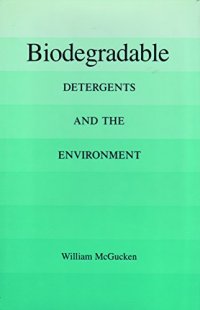
Ebook: Biodegradable: Detergents and the Environment
Author: William McGucken
- Tags: Pollution, Environmental, Civil & Environmental, Engineering, Engineering & Transportation, Waste Management, Environmental, Civil & Environmental, Engineering, Engineering & Transportation, Nature & Ecology, Animal Rights, Animals, Birdwatching, Conservation, Ecosystems, Endangered Species, Environment, Fauna, Field Guides, Forests & Rainforests, Lakes & Ponds, Mountains, Natural History, Natural Resources, Nature Writing & Essays, Oceans & Seas, Plants, Reference, Rivers, Rocks & Minerals, Star Gazing, Water Supply & Land Us
- Series: Environmental History Series
- Year: 1991
- Publisher: Texas A&M University Press
- Edition: 1
- Language: English
- pdf
Synthetic detergents rapidly replaced soap for most domestic cleaning purposes after World War II. Concurrently, great billows of foam began passing undegraded through sewage treatment plants into receiving waters, which were often sources for domestic water supplies. The detergent industry quickly learned that many surface-active agentsthe active ingredients of synthetic detergents and the producers of foamwere not readily biodegradable. The most popular surface-active agent was alkyl benzene sulfonate (ABS). Industrialized societies had developed satisfactory sewage processes to treat domestic wastes, but even the most advanced treatment facilities proved incapable of degrading ABS.
Biodegradable examines the development of synthetic detergents and the unanticipated pollution of surface waters and groundwaters by this new technology, as well as the social, political, and industrial responses that resulted in correction of the problem. Public and governmental pressure in the United States, the United Kingdom, and the Federal Republic of Germany led to the international detergent industry’s finding a biodegradable substitute for ABS, namely, linear alkyl sulfonate (LAS). Its use from the mid-1960s solved the foaming pollution problem.
The three countries responded to the problem very differently. West Germany almost immediately legislated that only those detergents that were more than eighty percent biodegradable could be sold. The U.S. government allowed the detergent industry to seek a solution while the Department of Health, Education, and Welfare monitored the industry’s progress. In the U.K. the government created committees and required industry to cooperate with them to find a solution. Biodegradable not only examines problems resulting from a new technology but also compares and contrasts different societies’ methods of dealing with these problems.
Biodegradable examines the development of synthetic detergents and the unanticipated pollution of surface waters and groundwaters by this new technology, as well as the social, political, and industrial responses that resulted in correction of the problem. Public and governmental pressure in the United States, the United Kingdom, and the Federal Republic of Germany led to the international detergent industry’s finding a biodegradable substitute for ABS, namely, linear alkyl sulfonate (LAS). Its use from the mid-1960s solved the foaming pollution problem.
The three countries responded to the problem very differently. West Germany almost immediately legislated that only those detergents that were more than eighty percent biodegradable could be sold. The U.S. government allowed the detergent industry to seek a solution while the Department of Health, Education, and Welfare monitored the industry’s progress. In the U.K. the government created committees and required industry to cooperate with them to find a solution. Biodegradable not only examines problems resulting from a new technology but also compares and contrasts different societies’ methods of dealing with these problems.
Download the book Biodegradable: Detergents and the Environment for free or read online
Continue reading on any device:

Last viewed books
Related books
{related-news}
Comments (0)